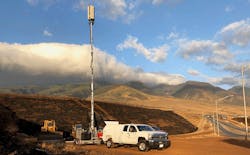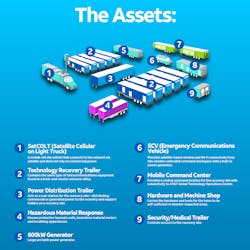Earlier this month, as wildfires in Maui destroyed an estimated 2,200 homes and caused economic losses of up to $6 billion, a quick response was needed to rebuild the island's telecom infrastructure, leading AT&T, which operates the nation's largest private fleet, to deploy its Network Disaster Recovery team to navigate the logistical quandary.
The NDR team most commonly responds to storms, where they usually get several days' notice to haul in and stage equipment before the disaster, Dwayne Moore, NDR's area manager, told FleetOwner. For wildfires, a rapid response is necessary as blazes ignite quickly without warning in unpredictable areas.
"It was a surprise to the entire community, even the firefighters and first responders," he said.
Hawaii was caught especially off guard, Moore said, compared to California, whose fire departments are more used to mobilizing quickly for wildfire response.
NDR Public Information Officer Kelly Morrison contrasted the Hawaii response to that of tropical storm Hilary, which flooded roads in Southern California last week.
Hawaii requires different logistics strategy
The NDR team has 14 generator pool sites staggered across the U.S., each with the generators and equipment necessary to rebuild AT&T's communications network in the wake of disasters.
"I can get a call anywhere, from Washington to Florida, and I can have a trailer with their equipment within a couple of hours and then the ground support that comes along with it," Moore said. "I'll operate a fleet of nearly 100 semi-trailers that are ready to go with generators on them, so we have thousands of generators that are ready at any time."
See also: Five Good Things: AT&T deploys rescue fleet in Hawaii
Responding in Hawaii, however, required a different strategy. Each island has equipment already, but AT&T also had to move equipment on barges from two other islands into Hawaii.
"Part of the strategy with Hawaii," Morrison said, "is dispersing equipment. By having equipment on different islands over there, including Maui, that let us do a very rapid response."
Additionally, the nearly 20 NDR workers who assisted local relief efforts had to be flown in from around the continental U.S.
"We've got assets all over the country," Moore said. "Being islands, it's a little more of a logistics challenge. If you're flying people from the mainland over to Hawaii—that's between a four and seven-hour flight, depending on where they originate."
Restoring first-responder service first
"Our primary mission is to get the first responders back up so they can do their job quickly," Moore said, "along with our regular customers so they can make their 911 calls and make calls to their families and loved ones."
The wildfires began Aug. 8, and AT&T restored service for first responders on Aug. 10.
Moving across Maui has been difficult, with the Hawaii Department of Transportation restricting travel along certain roadways due to the damages. However, Moore said that AT&T's NDR team, due to its close relationship with first responders, was able to make it through.
"The police department offered us escorts into the area, so we bypassed a lot of the standing traffic in those areas because of the police wanting to get that communication up quickly," Moore said. "And the fire departments too. They moved things out of our way to get us into those areas."
Repairs to Maui's infrastructure will be ongoing, and although internet fibers are damaged, AT&T has service restored.
"We have solutions, so we have service completely up in that area, and we're maintaining it through microwave solutions and through our satellite solutions now," Moore said, adding that construction crews are working the best they can and that "our main goal as a company is to get all of our network back on fiber."
Additionally, AT&T has donated $100,000 to relief efforts: $50,000 to the Hawaii Community Foundation, $30,000 to the Information Technology Disaster Resource Center, and $20,000 to the American Red Cross.







